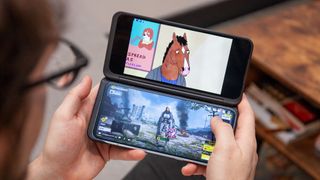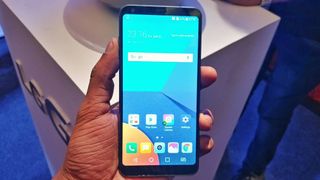5 truly wild LG phone innovations – and why they failed
After LG closed its phone division, we remember a legacy of experiments and innovations

Update: LG has officially quit the phone business. While not entirely surprising, it does bring an end to a legacy of novel and interesting phones that didn't quite capture consumer interest and change the market. Here's their most interesting flops:
Get ready to pour one out: rumor has it that LG will finally announce that it’s leaving the phones business entirely in the coming days. It’s no secret that the company’s smartphone sales haven’t been stellar in recent years, but if it does pull the plug, we’ll lose out on a phonemaker has continued to push the form and function of today’s handsets.
Granted, few of LG’s experiments have made a big impact on the phones industry: its most exciting designs just seemed to prove how intractable the ‘black rectangle’ standard for smartphones has become. The market has proven that consumers will largely buy phones in a single format that’s been honed to a high finish in the better part of the last decade; any new designs are held to that standard, and their deviation is held against them.
Then again, LG”s more exciting models simply haven’t delivered the polish that consumers have come to expect.
Here's the 5 models and their interesting innovations that didn't land with consumers.

LG Wing 5G
The swing-out design of the 2020 LG Wing 5G is a truly novel: use it like a normal phone until you need more screen, and then flip out a half-sized bonus display for small tasks (texting, quick online searches, navigation) while keeping the main screen playing media or whatnot.
But in practice, it’s tougher to wrangle apps on the extra display than it is on leading single-screen iOS and Android phones, making it easier to just switch between apps on the latter than struggle with the unpolished UX on the former. That makes all the difference.
Get daily insight, inspiration and deals in your inbox
Get the hottest deals available in your inbox plus news, reviews, opinion, analysis and more from the TechRadar team.

Dual Screen (LG V60 / G8X)
The dual screen accessory for the 2020 LG V60 and 2019 LG G8X is a lower-tech yet affordable alternative to expensive foldable phones: get a second screen that plugs into your main phone and can essentially be used to run two apps at once (or, in rare cases, one app across both screens). And unlike the Microsoft Duo, you can pull either phone out of the Dual Screen accessory and use it as a fully-functional handset.
But the accessory simply didn't catch on: perhaps, without the flash of the next-gen seamless foldable design, the Dual Screen wasn't appealing enough. More likely, multi-screen appeal just hasn't grown enough to whet consumer appetites. It doesn't help that the implementation wasn't quite polished enough to let users intuitively swap apps with finger gestures (there's some menu finagling first).

LG G5: modular ends
The LG G5 featured modules that let you swap out the phone’s endcap for a camera grip or 360 camera –like Moto Mods, but switching out parts of the actual handset. And like Motorola's add-ons, they weren't exactly revolutionary and didn't add must-have functionality to differentiate the phone from others on the market.
Also, the LG G5 was probably one of the last phones to offer a removable battery to swap out for a spare, but at the time we disliked the removable backplate and preferred seamless phone designs.
LG V50: vein-tracking aerial gestures
The LG V50 was one of the first phones to add 5G connectivity when it launched in 2019, but that wasn't its selling point: it recognized in-air hand gestures via a suite of sensors alongside the front-facing camera. These supposedly tracked hand motions by tracking your veins, which is as fascinating as it is eerie.
Unfortunately, the gesture recognition wasn't too accurate, and it didn't enable much in the way of controls, either.

LG G4: leather back, 'knock code' unlocking
The LG G4 had a curved display, optional svelte leather back (and not at sportscar edition prices), and a ‘knock code’ let you unlock the phone by tapping the screen in a specific pattern. Or at least that was how the ‘knock code’ concept should have worked, but its implementation never seemed to work as advertised, and the industry-standard fingerprint scanner found on competing iPhones and Android handsets were simpler and easier to use.
LG G10
Not all of these experiments were wacky divergences from modern smartphone design, either – many attempted to solve common frustrations with quirks that didn’t quite innovate enough. The LG V10 added a secondary 2.1-inch display above the main screen dedicated to notifications and shortcuts, which kept the primary display clear when watching movies or when it was locked.
The secondary display was narrow and, while a border between the screens would have been unsightly, it was tough to find where one ended and the other began, making it harder to flip through apps up top.
Novel innovation, but unsatisfying execution
That might be the summation of most of LG’s experiments: novel concepts, but the execution isn’t fluidly intuitive enough to lure folks away from the status quo.
But that’s a pithy observation which ignores the market’s history: while the LG G2 reigned supreme in 2012, the company faced fierce competition from Samsung and HTC handsets, so it tried adding new quirks to stand out. If there’s anything LG is guilty of, it’s retaining this experimental mindset while the Android landscape quietly shifted to coalesce around a single design – the ‘black rectangle’ of edge-to-edge screen, single selfie camera in a notch/punch-hole, and multiple rear cameras on an otherwise unblemished back cover.

While the LG G6 follows this trend, by the time it came out in early 2017, this model was being undercut by cheaper iterations of the black rectangle by Xiaomi, Huawei, Oppo, and OnePlus. We know how that’s played out – and latter-day LG flagships, even solid ones like the LG V60, just haven’t offered enough for their price relative to these more affordable competitors to stand out in the marketplace.
It makes sense that LG would continue to try new designs like the Dual Screen and LG Wing, hoping for a novel yet cheap alternative to flashy foldable phones that would really connect with consumers. It turns out that the flat full main display of your average smartphone has been refined enough that new designs are now a bit too alien, which is a sad reality.
And that shouldn’t discount LG phones’ more mundane innovations that did end up changing the course of phone design. The LG G3 debuted one of the first Quad HD resolution (1440 x 2560) displays and Qi wireless charging, while the aforementioned V10 also debuted dual front-facing cameras enabling ultra-wide selfies.
If LG’s phone division goes quietly into that dark night, we’ll probably be in store for more of the same for years to come. But at least there are some among us who will remember the strides that companies used to make experimenting with phones – and making them fun, too.
- Stay on top of tech news with the TechRadar newsletter
David is now a mobile reporter at Cnet. Formerly Mobile Editor, US for TechRadar, he covered phones, tablets, and wearables. He still thinks the iPhone 4 is the best-looking smartphone ever made. He's most interested in technology, gaming and culture – and where they overlap and change our lives. His current beat explores how our on-the-go existence is affected by new gadgets, carrier coverage expansions, and corporate strategy shifts.
Most Popular



